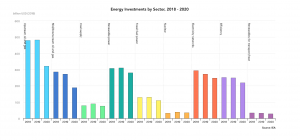Energy is a resource that produces and supplies electricity/fuel for the global economy and has been in high demand for many years. They are one of the 11 sectors defined by the Global Classification Standard (GICS). The energy sector consists of traditional energy companies like oil producers, power plants, utility companies, oil refineries and gas stations. In more recent years, we’re seeing a change in the dynamics and power play in this sector as clean energy companies have joined the fray. These include solar energy companies, wind farms and basically any other business that is focused on technology used to generate, store and deliver clean power.
Companies that operate in this sector generally fall into five main categories/industries (1):
- Mining and processing of coal and oil sands i.e. bitumen, which are directly used for generating electricity or making liquid fuels.
- Generation of electricity directly from fossil fuels and cleaner, renewable energy sources and the distribution of power and natural gas by utilities.
- Upstream exploration and production of oil, natural gas and related liquids.
- Midstream transportation, processing and storage of natural gas and liquids.
- The downstream refining, marketing and distribution of petroleum products.
The Covid-19 pandemic of 2020 has made it abundantly clear that energy prices can change in a heartbeat and this unpredictability makes the energy sector a challenging environment for investors to partake in. To put this into perspective, during the Covid-19 shutdowns, many industries were brought to a standstill. Almost all investment activity had faced some disruption, whether it be because of restrictions of movement of people or goods, or because the supply of machinery/equipment was interrupted. As a result, oil demand and prices plummeted, which also led to more uncertain expectations for these factors in the years ahead. This downturn weighed heavily on oil company stock prices and as a consequence, several companies in the sector had to even file for bankruptcy. This bring to question the viability of pursuing traditional energy stocks (fossil-fuel driven stocks), which are becoming increasing volatile and risky for investors.
From an energy investing perspective, what this translates to is ensuring that as an investor, bundling all of your investments into one energy stock or industry is ill-advised. The stock market is in constant flux and individual stocks can change prices second by second. To balance the outcome of an economic slowdown, investors should keep the downside risk in mind and accordingly allocate and diversify their portfolio into more stable stocks i.e. renewable energy stocks, as a way to provide insulation against fluctuating market conditions and inflation. Ultimately, the goal should be to transition away from energy stocks driven by fossil fuels, which are proving time and time again to be erratic, not to mention, worsening the impacts of climate change!
Renewable energy stocks present a unique way for investors looking to get involved in energy-related investments. You can invest in these stocks in a number of ways, including ETF’s and mutual funds (substantial exposure and diversification without direct risk); large market cap stocks (provides stability and lesser exposure to market fluctuation)and; future contracts (purchase derivatives – a riskier investment approach given that future contracts may not yield any returns).
Before investing in any instrument, consider studying the underlying asset. For example, solar stocks are a compelling renewable energy industry for long-term investors as these energy infrastructure assets generate stable cash flows, backed by regulated rates. In some cases, income from certain energy stocks may be tax-sheltered – an equally attractive incentive for investors. Solar stocks present a low-risk business model and has proven to be highly durable during Covid-19. Oil stocks, on the other hand, have experienced the opposite trend during this period due to it being a commodity largely driven by supply and demand. Market research is key, and one needs to also keep an eye out on regulations and changes in policy play to prevent major losses and also make the most of political changes and policies.

There are plenty of attractive investment opportunities in the energy sector, more specifically in the renewable energy subsector, that will give investors the confidence to participate in such ventures. The breadth of stock options currently available in the market delivers a convincing case to consider renewable energy stocks as a portfolio diversification strategy. Hundreds of public companies provide these stock options – most of which focus on production and distribution of energy. Notable mentions include Brookfield Renewable Partners (operates a global, multi-technology platform that includes wind/solar generation facilities), NextEra Energy (utility and renewable energy producer) and First Solar (leaders in developing thin-film solar panels).
Over the past ten years, power sector spending has been relatively stable compared with oil and gas, which have fluctuated markedly. Investments in the electricity generation sector is set to outpace investments in fuel supply for the fifth year in a row. This is driven by several factors – energy transition strategies; growth in electricity demand; structural pressures to reduce emissions and; a growing switch to cleaner technologies. Energy has increasingly become the front line for the world’s push for sustainable development and been a catalyst for rising investments in renewable energy stocks, particularly solar stocks. According to the IEA, global renewable energy capacity is on track to expand by 1,200 gigawatts (GW) from 2019 to 2024, with solar powering 60% of that growth.
If you’re a beginner, or even an intermediate investor new to the energy sector and aren’t sure where to start with regard to your energy sector allocation, renewable energy stocks are an attractive option; there are plenty of household names that offer these stock options, which also tend to make more stable investments over the long-term. If you’re looking to make investments in lesser-known companies then dig into their financial data, make sure the company is profitable, invest in companies that are actually producing a product and last but not least, see if their involved in renewable energy. The last point is important because while fossil fuels are going nowhere anytime soon, as clean energy continues to gain traction, the likely and if not already evident result is the demand and price for oil will fall over the long term. The Organization of the Petroleum Exporting Countries (OPEC) projects by 2045, nuclear, biomass and renewables will comprise 27.5% of the world’s energy demand, up from 18.7% currently.
Investors should take note of the increasing number of companies that are venturing into the clean energy subsector. Those that ignore this shift risk failing to hedge their bets, which could lead to long-term losses.
References:
- https://www.fool.com/investing/stock-market/market-sectors/energy/








